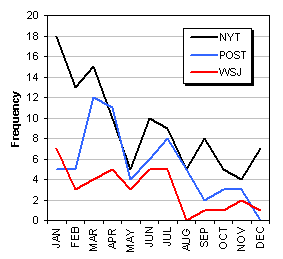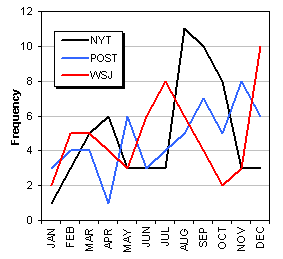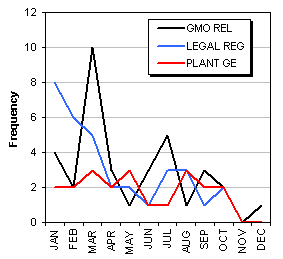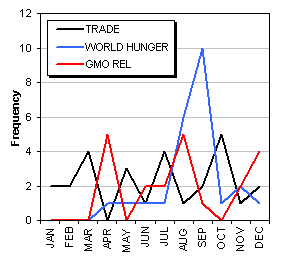|
In contrast to our European counterparts, Americans have not demonstrated strong opinions about agricultural biotechnology. Nor has American awareness of agricultural biotechnology changed substantially over time (IFIC, 2001). Both the public's lack of familiarity with agricultural biotechnology and their limited perception of its relevance in daily living influence their perspectives toward the technology. This overall lack of public understanding creates an environment in which whatever information people are told is more likely to become what they believe.
Media agenda-setting theory posits that what is reported in the media sets the agenda for what public issues individuals consider to be important (McCombs & Shaw, 1972). Empirical evidence has shown that agenda-setting effects of media are minimal for obtrusive issues, issues with which individuals have direct experience. However, agenda-setting effects of the media are strong for unobtrusive, indirectly experienced issues because the public has a need for orientation to those issues, particularly when an issue is perceived as personally relevant to the reader. For most Americans, genetic modification through agricultural biotechnology is an unfamiliar and abstract concept, lacking any real context. In agenda-setting theory terms, it is an unobtrusive issue.
Studies of "second level" agenda-setting, or "attribute" agenda-setting, have shown that media presentations affect public perceptions not only regarding what issues are important, but also what aspects of those issues are important. Both what and how the media report on a topic is reflected in public understanding and opinion about that issue.
Space in the "daily news hole" is often event driven; that is, reporters will cover what is news today, increasing awareness of, in contrast to educating or informing the public on, an issue. Becoming aware of an issue is necessary, yet not sufficient, to become informed or take action on the topic. To do so also requires that an issue becomes salient. Media effects research shows that for an issue to become salient it must be covered with high frequency over a period of time. Coverage of peak events, that is, greater coverage of a topic over a period of time, increases the likelihood that the critical event that is covered will capture the public's attention, providing an opportunity for the issue to become salient for Americans. Thus, critical events which garner peak coverage can put the topic on the public's "radar screen."
Furthermore, peak events may provide an opportunity for information from a diversity of sources to reach decision-makers and the public (Abbott & Lucht, 2000). Controversy carries news value and often creates a media hoopla, or a peak in coverage, where journalists cover a topic with vigor. When an issue is seen as more controversial, journalists, guided by the norm of objectivity, may attempt to present opposing viewpoints. Because most newspaper stories are based on information provided by sources (Gandy, 1982; Soloski, 1989), print media sources for information on agricultural biotechnology have the potential to strongly influence what the public reads about this technology. Therefore, it is essential that those sources effectively frame information for the public's understanding so that information is what will be remembered.
Based on our knowledge of how media can influence public opinion, plus the American public's limited knowledge regarding biotechnology and GM foods, mass media coverage of agricultural biotechnology has the potential to strongly influence public opinion, particularly through critical event peak coverage. Therefore, we investigated what the media reports in overall and in peak coverage. Our analysis of news copy shows not only what topics garner coverage and who provides the relevant information, but also the extent to which a topic is covered and how.
The newspapers selected for our study, the New York Times, the Washington Post and the Wall Street Journal, have a combined national readership over 3.6 million (Editor & Publisher, 2000). Media studies have asserted that articles in the national newspapers tend to spread vertically through the news hierarchy, setting the national news agenda (Gitlin, 1980). These national papers, touted as "breakfast reading for congress," the "unofficial newspaper of record" (Ulrich, 2002), and "the publication of choice for capitalism's brightest stars" respectively, command attention. In fact, according to Herman and McChesney (1997:138), three national newspapers in the United States, the New York Times, the Wall Street Journal, and USA Today, along with the news agencies, "set the agenda for the rest of the press and for broadcasters as well." Because of this, the potential exists for articles carried in these nationals to travel not only through the news hierarchy to other newspapers published by the national firms, reaching a readership close to 12 million (Editor & Publisher, 2000), but also to other news outlets across the U.S. If so, coverage of agricultural biotechnology by local or regional papers is likely to follow the same pattern as that of the nationals.
Our analysis of U.S. print media coverage of agricultural biotechnology in 2001 and 2002 indicates that national coverage of agricultural biotechnology is quite limited. A comprehensive key word search of articles published during these two years in the New York Times, Washington Post, and Wall Street Journal found just 210 articles were published in 2001 and 173 in 2002, see Table 1.
Peaks in Coverage
Across two years these three national papers published only 383 articles, or an average of 16 a month. This coverage was a mix of baseline and peak coverage. Such a peak is evident in early 2001 (see Figure 1). In 2002 (see Figure 2), elevated coverage is extended through several months. In both years, peak coverage is most clearly illustrated through the New York Times, also reflecting The Times more frequent coverage of agricultural biotechnology overall.
In 2001 and 2002, agricultural biotechnology coverage was most often found on page one of the section in which it appeared. Peak events were most often reported as breaking news, printed in the front section, and more often than not, on the first page. Further statistical analysis revealed peaks in coverage for two of the most frequently reported themes, GMO release in 2001 and world hunger in 2002.
In 2001, GMO release, identified in 35 articles, was one of the three most frequent themes covered. Figure 3 shows a peak in coverage with 10 articles in March. Legal regulation and general articles about plant genetic engineering were the other two most frequent themes in 2001 with 33 and 21 articles, respectively. However, neither are representative of peak coverage, for this coverage occurred throughout the year.
In 2002, coverage discussing agricultural biotechnology's role in world hunger, the second most frequent theme for the year (N=24), peaked with six articles in August and ten in September (see Figure 4). Coverage of agricultural biotechnology in which trade was the primary theme, in 27 articles, occurred throughout the year. GMO release was again one of the three most frequent themes, appearing in 21 articles. However, in 2002 this theme showed no peak in coverage.
As the issue changes, what is pertinent to one topic may not be so for another. To further understand what is reported, we looked at sources cited in such coverage and how the risks and benefits of the issue are reported; that is, the tone.
Sources in Articles
Sources are not consistently used. Across all agricultural biotechnology articles in 2001, almost one-third cited none (61, 29% in 2001; 63, 36% in 2002). In 2001, U.S. government sources were most frequently cited in both overall coverage (39 articles, 19%) and within peak coverage of GMO release (10 articles, 29%). The next most frequently cited sources in overall coverage were industry affiliated (19 of 210, 9%). However, industry sources were cited in only 6% of peak GMO release articles. Activist groups were cited third most frequently in overall coverage, in 15 of 210 (7%) articles, whereas activist groups were cited second most frequently, 9% of the time, in GMO release articles.
Among the articles citing a source in 2002 (110 of 173, 64%), the most frequently cited sources were industry affiliated (21 of 173, 12%), comprising almost one-fifth (21 of 110, 19%) of all agricultural biotechnology sources of information. The next most frequently cited sources were U.S. government affiliated (16 of 173, 9%), followed by university-affiliated sources (12 of 173, 7%). Activists (all types) were cited 11 (6%) times. Farmers were only cited four (2%) times.
However, in the 2002 peak coverage of world hunger, U.N. affiliated and developing nation government sources were most frequently cited. This pattern is not consistent with the most frequently cited sources in overall coverage for 2002; the pattern changed. In the case of the world hunger peak, the topic being discussed allowed for a diversity of sources, thus far silent. It appears that sources cited reflect their relevance to the topic. A greater diversity of topic coverage provided public access to a greater diversity of sources of information.
The use of acknowledged sources in agricultural biotechnology reporting is surprisingly limited. With few exceptions, U.S. government and industry are more often referenced than are other sources. However, as the world hunger theme illustrates, a controversial critical event garnering peak coverage may provide an opportunity to hear from a greater diversity of information sources.
Tone of Articles
Most often in both 2001 and 2002, articles emphasized neither the risks nor benefits of agricultural biotechnology (36% in 2001; 36% in 2002). Less often, both the risks and benefits were covered (29% in 2001; 20% in 2002). However, in peak GMO release coverage in 2001 risks were most often emphasized. In fact, in GMO release peak coverage in 2001 and in GMO release baseline coverage in 2002, risks were highlighted, 56% and 71%, respectively. Therefore, tone appears to reflect the topic, not type, of coverage.
As in 2001, articles published in 2002 most frequently mentioned neither risks nor benefits of the technology (36%). However, in peak coverage of world hunger, both risks and benefits were mentioned most often (45% of articles). Peak thematic coverage differs in tone from overall coverage. As the world hunger theme illustrates, a controversial critical event garnering peak coverage may also provide an opportunity to discuss the risks and benefits of this technology.
Given that overall coverage of agricultural biotechnology emphasized neither risks nor benefits, the public is provided little information with which to understand what, for many, is a critical question: Is agricultural biotechnology beneficial or not to the environment, our quality of life, and our economic welfare? Raising and discussing the risk/benefit question for the public is likely to encourage greater cognitive elaboration, or thinking, about agricultural biotechnology, particularly when the public is provided with the motivation to do so, for instance, through peak coverage of a "critical" event.
Crafting Effective Messages, Media Coverage to Remember
Our research indicates that how topics are covered varies across the issue, as well as within the issue. Even though print media coverage of agricultural biotechnology is limited—both in the extent of such coverage as well as what issues are covered and how—such information is essential to engage broader citizen awareness on a topic.
In a national survey by Hallman et al. (2004), respondents were asked if they recalled several agricultural biotechnology news stories. Almost one-quarter (24%) indicated that they remembered the world hunger peak event, the African refusal of GM grain food aid, even though this peak only occurred over two months in 2002. In contrast, only 7% remembered any Bt pollen/Monarch stories, categorized as a GMO release, that surfaced through a much longer peak in coverage, from June to December in 1999. Given the large media hoopla generated by this story, one might expect a much higher story recall. World hunger, a theme that emerged in 2002, is representative of peak coverage and is remembered. Although the Monarch peak occurred three years prior to the world hunger critical event, time may not be the only explanation for this difference in story recall.
Framing can provide a way to link the unfamiliar with the familiar, not only addressing one of the dimensions by which individuals assess risk, but also enhancing recall of a topic. The more often a schema and its connections are activated, the more those memories are reinforced, and the more likely they are to be retrieved. Much of the public of the developed world shares an inaccurate image of developing countries. Cate (1994) states that Adamson, founder and author of UNICEF's annual State of the World's Children report, argues that the public has "an impression that the developing world is a theater of tragedy in which poverty and human misery figure prominently in almost every scene." In addition, media often portray the West as a Samaritan figure providing aid in a time of need to countries in Africa. Accounts of suffering and relief fall, almost without exception, into "a pre-set narrative" that portrays helpless victims and "heroic saviors." When agricultural biotechnology is linked to this narrative it is not only more likely to be remembered, but it is also more likely to be perceived as less risky because it is paired with a more familiar concept, feeding the world's hungry.
As we know, consumers often voice concerns about agricultural biotechnology, viewing it as a risky technology. Risk assessment can also be influenced by framing a decision in terms of losses and gains (Tversky & Kahneman, 1986). Framing a decision in terms of loss makes the loss more salient to the decision maker. If a risk is framed in terms of loss, then the risk is seen as an opportunity to avoid loss and an individual will take more risk to avoid loss than to chance a gain (Highhouse & Yuce, 1996).
In fact, when discussing the differences in consumer perceptions between medical and agricultural biotechnology, Wansink and Kim (2001) assert that medical biotechnology is often framed as avoiding a loss and agricultural biotechnology is framed as an improvement on a product that is already perceived to be sufficient by American consumers, a gain. When acceptance of agricultural biotechnology is framed as avoiding massive loss of human lives, as in the case for world hunger, we see that perceived risks of the technology are likely to be accepted to avoid a loss (of human life). The decision to accept a risk is simplified when it prevents such tragic loss. Acceptance of agricultural biotechnology is now linked with alleviation of starvation in the "Third World." What Americans have not sat guiltily munching down snacks as that nagging "Save the Children" imagery pops up on their television screens? The decision to accept a technology that is purported to avert the loss of human lives is easy. The Bt pollen/Monarch stories framed acceptance of agricultural biotechnology as potentially causing loss, ecological loss. However, unlike ecological concepts involving Monarch butterflies, images of starving children provide a link with an established schema, cultivated through media and culture. Although we may lament the loss of a species of butterfly, for most of us, it has little meaning to us directly, unlike the loss of human life.
Emotional imagery such as starving children portrays agricultural biotechnology as a beneficial solution to world hunger. Effective framing uses imagery to package the message in a form that is easily understood, minimizing issue complexity. Cues drawing on emotional imagery (Wansink & Kim, 2001) ease the cognitive burden of processing information, reducing the complex social implications of agricultural biotechnology to a scientific breakthrough to alleviate misery and reducing ambiguity through compelling emotional cues. Furthermore, emotion increases arousal, enhancing the chances of effective storage in memory.
When the media is essentially the sole provider of information on a topic, the public is apt to understand the issue in the same manner as the media portrayed it. Because of the complexity of agricultural biotechnology and its perceived lack of relevance for Americans, using cues such as emotional imagery can be more effective than scientific information in increasing the public's awareness of and comfort with agricultural biotechnology. Little direct experience with agricultural biotechnology leaves the public in the position of gaining understanding of this complex technology and the social and economic implications of its use through the media's coverage. Peak coverage can increase awareness of an issue, helping the public to remember, particularly when that coverage is framed as an event to remember.
For More Information
Abbott, E., & Lucht, T. (2000, July). How triggering events affect mass media coverage and source use concerning genetically modified organisms in Britain and the United States. Paper presented to the Agricultural Communicators in Education USACC 2000 Congress, Washington D.C.
Cate, F.H. (Ed.). (1994). International disaster communications: Harnessing the power of communications to avert disasters and save lives. Washington, D.C.: The Annenberg Washington Program in Communications Policy Studies of Northwestern University. Available online: http://www.annenberg.northwestern.edu/pubs/disas/disas10.htm (Accessed August 2004).
Editor & Publisher (2000). Audit Bureau of Circulation. Available online: http://www.naa.org/info/facts00/14.html.
Gandy, O.H. Jr. (1982). Beyond agenda-setting: Information subsidies and public policy. Norwood, NJ: Ablex.
Gitlin, T. (1980). The whole world is watching: Mass media in the making and unmaking of the new left. Berkeley: University of California Press.
Hallman, W.K., Hebden, W.C., Cuite, C.L., Aquino, H.L., & Lang, J.T. (2004). Americans and GM food: Knowledge, opinion, and interest in 2004. Food Policy Institute report RR-1104-007, Rutgers University.
Herman, E., & McChesney, R. (1997). The global media: The new missionaries of corporate capitalism. London: Continuum.
Highhouse, S., & Yuce P. (1996). Perspectives, perceptions, and risk taking behavior [Electronic version]. Organizational Behavior and Human Decision Processes, 65, 159-167. Retrieved on February 29, 2004 from JSTOR.
International Food Information Center (IFIC). (2001). U.S. consumer attitudes toward food biotechnology. Available online: http://www.ific.org (Accessed August 2004).
McCombs, M.F., & Shaw, D.L. (1972). The agenda-setting function of mass media. Public Opinion Quarterly, 36, 176-187.
Soloski, J. (1989). Sources and channels of local news. Journalism Quarterly, 66, 864-870.
Tversky, A., & Kahneman, D. (1986). The behavioral foundations of economic theory. The Journal of Business, 59, S251-S278.
Ulrich's International Guide to Periodicals (2002). Vol. 5. New Providence, N.J.: Bowker.
Wansink, B., & Kim, J. (2001). The marketing battle over genetically modified foods: False assumptions about consumer behavior. American Behavioral Scientist, 44, 1405-1417.
|
|
Other articles in this theme:
|
|
Table 1
Frequency of Agricultural Biotechnology Articles in 2001 and 2002 in The New York Times, Washington Post, and Wall Street Journal.
| 2001 |
210 |
109 |
64 |
37 |
| 2002 |
173 |
59 |
56 |
58 |
|
|




